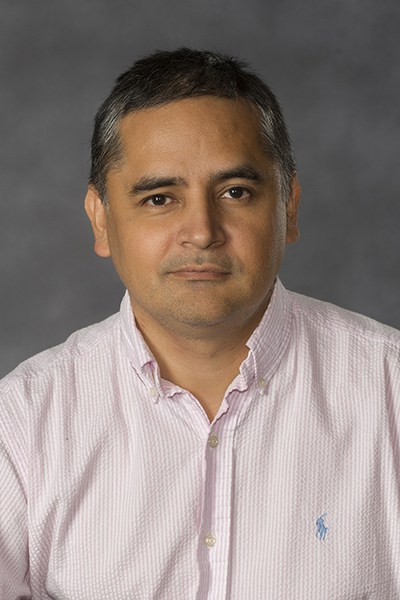
Julio Alvarez, Ph.D.
Associate Professor
jcalvarez2@vcu.edu
804-316-5094
Oliver Hall 4025
Education
B.S., Universidad del Tolima, Ibague, Colombia, 1989
M.S., Universidad del Valle, Cali, Colombia, 1996
Ph.D., University of Miami, Coral Gables, FL., 2000
Postdoctoral Research, Texas A&M University, College Station, TX, 2000-2004
Honors and awards
National Science Foundation Career Award 2007
Excellence in Scholarship Award, College of Humanities and Sciences, VCU, 2007
Outstanding Graduate Student Award, University of Miami, 2000
Research interests
Research in our lab focuses on developing electrochemical methods to characterize single particles like cells and microdroplets for bioanalytical and medical applications. Students gain experience in electroanalytical techniques to characterize molecular and particulate entities for sensing applications or to elucidate complex electrochemical mechanisms. Other methodologies that are used in our lab depending on the project may include: UV-Vis/Fluorescence Spectroscopy, Electron Microscopy, XPS, NMR, Mass Spectrometry, cell-culturing techniques, ultramicroelectrode fabrication, and simulations with commercial software packages like DigiSim, MatLab and COMSOL Multiphysics. Currently we are pursuing projects in the following areas:
Single Entity Electrochemistry
Single Entity Electrochemistry comprises a series of techniques recently developed to analyze nano- and microparticles as they collide in real time with electrodes of comparable size. Depending on the redox properties of the particle and electrode, particle collisions generate stochastic and discrete signals from which particle properties can be inferred. Because the signal also depends on particle arrival velocity, characterizing particle behavior also requires accounting for transport
mode (diffusion, electromigration, etc.). Therefore, our goal is to develop quantitative models that relate signal and particle properties to find discrimination markers. For example, we found that arrival velocity of bacteria correlates with bacillus length and could be used as a size marker in mixed samples. We intend to apply a similar approach to other cells (yeast, cancer, etc.) while investigating physiological states. On the other hand, emulsion droplets constitute a good model
system that can be loaded with redox mediators to study single entity fundamentals. For instance, we recently demonstrated that particle sensing based on adsorption is more efficient in signal yield and speed than sensing through particle bouncing collisions. We also found that single droplet electrochemistry can reveal intra-droplet partition that arises from non-covalent interactions like hydrogen bonding.
Ahmed, J.U., Lutkenhaus, J.A., Tubbs, A., Nag, A., Christopher, J., and Alvarez, J.C., “Estimating Average Velocities of Particle Arrival Using the Time Duration of the Current Signal in Stochastic Blocking Electrochemistry”, Anal. Chem., 2022, 94, 16560-16569
Ahmed, J.U., Lutkenhaus, J.A., Alam, M.S., Marshall, I., Paul, D.K., Alvarez, J.C., “Dynamics of Collisions and Adsorption in the Stochastic Electrochemistry of Emulsion Microdroplets”, Anal. Chem., 2021, 93, 7993-8001.
Paul, D., Meng, K., Omanovic, D., Alvarez, J.C.; “Hydrogen Bonding and Proton Transfer in Aqueous Toluene Microdroplets Studied by Particle Collision Electrochemistry”, ChemElectroChem, 2018, 5, 2528-2533.
Reaction Mechanisms of Complex Redox Reactions
Our goal is to investigate structure-reactivity principles that govern the concerted transfer of protons and electrons (proton-coupled electron transfer or PCET) in reactions that produce electrochemical energy. In living systems, PCET reactions are responsible for biochemical energy production (i.e. photosynthesis, respiration, etc.) and are believed to follow a concerted pathway as a way to maximize kinetic and thermodynamic efficiency. Currently there is no catalyst recipe for recreating the molecular conditions that elicit the dominance of the concerted PCET pathway to produce renewable electrochemical energy cheaply and efficiently. We aim to elucidate how pKa and redox potential determine the rate and dominance of the concerted pathway in comparison to the sequential routes at different thermodynamic gradients. For this purpose, we work with model systems that allow systematic variation of pKa and redox potential in different conditions.
Meng, K., Medina-Ramos, J., Yibeltal-Ashenafi, E., Alvarez, J.C.; “Interplay of Proton and Electron Transfer to Determine Concerted Behavior in the Proton-Coupled Electron Transfer of Glutathione Oxidation”, Phys. Chem. Chem. Phys., 2018, 20, 17666 – 17675. (Selected as part of the hot article list of 2018 by the journal)
Medina-Ramos, J., Oyesanya, O., Alvarez, J. C.; “Buffer Effects in the Kinetics of Concerted Proton-Coupled Electron Transfer: The Electrochemical Oxidation of Glutathione Mediated by [IrCl6] 2− at Variable Buffer pK a and Concentration”, J. Phys. Chem. C, 2013, 117, 902-912
Sensing with Streaming Potentials
The surface of microchannels is used as charge-sensing element for detecting adsorbing molecules or particles on the surface by monitoring the streaming potential. This is a spontaneous ion gradient generated when solutions move through a microchannel by pressure-driven flow. At the microscopic interface between the liquid and the surface, the forward liquid flow creates a downstream excess of surface counterions which is manifested as a potential difference along the
flow axis and can be detected by two electrodes located at the outlets of the microchannel. Adsorption processes can be detected by measuring the polarity and magnitude of the potential, which is also proportional to the liquid pressure and the Z-potential of the microchannel surface.
Wu, J., Zhang, Y., Zhao, L., Zou, L., Alvarez, J. C., Pu, Q.; “Towards Robust Biosensors Based on Pulsed Streaming Potentials in Microfluidic Channels: Online Correction and Output Signal Selection”, Sens. Actuact. B, 2012, 174, 18-23
Luna-Vera, F., Ferguson, J. D., Alvarez, J.C, “Real Time Detection of Lysozyme by Pulsed Streaming Potentials Using Polyclonal Antibodies Immobilized on a Renewable Nonfouling Surface Inside Plastic Microfluidic Channels”, Anal. Chem., 2011, 83, 2012-2019.